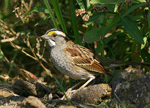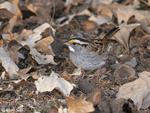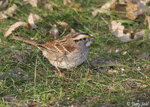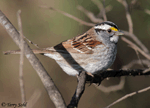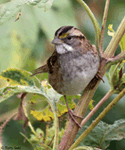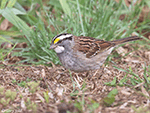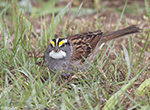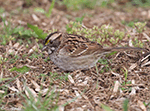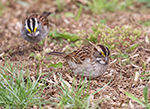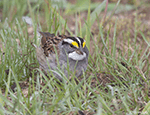White-throated Sparrow
Zonotrichia albicollis
| Length: 6.75 inches | Wingspan: 9.5 inches | Seasonality: Migrant |
| ID Keys: White throat, black and white (or tan) stripes on head, 2 white wing bars. | ||
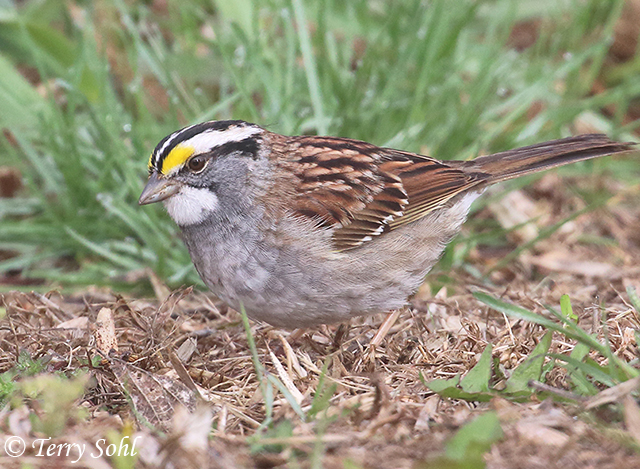 The White-throated Sparrow
can have head stripes of either white or tan, alternating with black (see the
bottom of the page for photos of both color morphs). Individual birds
strongly prefer to mate with one color morph of the opposite sex, with males
strongly preferring white-striped females, and females strongly preferring
tan-striped males. Other curious differences occur between the
color morphs: 1) White-striped females sing, but tan-striped females do not, 2)
white-striped males are generally more aggressive and do more singing than
tan-striped males, and 3) tan-striped male and white-striped female pairs tend
to bond more quickly than the opposite combination.
The White-throated Sparrow
can have head stripes of either white or tan, alternating with black (see the
bottom of the page for photos of both color morphs). Individual birds
strongly prefer to mate with one color morph of the opposite sex, with males
strongly preferring white-striped females, and females strongly preferring
tan-striped males. Other curious differences occur between the
color morphs: 1) White-striped females sing, but tan-striped females do not, 2)
white-striped males are generally more aggressive and do more singing than
tan-striped males, and 3) tan-striped male and white-striped female pairs tend
to bond more quickly than the opposite combination.
White-throated Sparrows nest in the northern and eastern US, and are but migrants in South Dakota. They are more commonly seen in the eastern part of the state than in the west.
Habitat:
During the summer breeding season, White-throated Sparrows are found around deciduous or conifer forest areas, typically hanging out along the edges of forest clearings, in the shrubby woodland undergrowth, or in second-growth shrrubby forest land that's regenerating after a fire, a clear-cut, or other disturbance activity. During migration and in winter they use a wider variety of habitats but are generally found around shrubby and brushy areas such as woodland edges and undergrowth, agricultural woodlots, shelterbelts, riparian areas, and residential areas and parks.
Diet:
Primarily insects during the summer, seeds and berries in the fall and winter. Will attend bird feeders for commonly offered seeds.
Behavior:
Primarily forages on the ground, typically near or beneath thick vegetation.
Breeding:
Non-breeder in South Dakota. On their breeding grounds, the nest is usually built on the ground, but they will sometimes place it low in a bush or small tree. The nest is constructed of grasses, twigs, rootlets, pine needles, and other vegetative material, lined with hair, fine grasses, or feathers. The female builds the nest, and lays between 3 and 6 pale bluish eggs with purplish-brown spots. The young hatch after about 12-14 days, and fledge from the nest about 12 days after hatching.
Song:
The song is a series of thin whistles often described as poor-sam-peabody-peabody-peabody or my sweet canada-canada-canada. They also have multiple calls notes, including a short trill or a sharp chink note.
- Click here to hear the sharp chink call of a White-throated Sparrow, recorded in Quebec1
- Click here to hear the song of a White-throated Sparrow, recorded in Quebec2
Migration:
Summers in New England, the Great Lakes Region, and much of Canada. Winters in the southeastern third of the United States and points south. They are common migrants in South Dakota, particularly in the eastern part of the state.
Interactive eBird Map:
Click here to access an interactive eBird map of White-throated Sparrow sightings
Similar Species:
If seen well, key features make them readily identifiable, but they could potentially be confused with the following species:
- White-crowned Sparrow - An adult White-crowned Sparrow has similar black-and-white striping on the head, like the white-striped version of the White-throated Sparrow. However, White-crowned Sparrows have a plain gray throat that doesn't contrast with their belly or cheeks, as opposed to the white throat of a White-throated Sparrow. White-crowned Sparrows also lack the yellow that's found in front of the eye on a White-throated Sparrow. Immature White-crowned Sparrows lack the white-throat of a immature White-throated Sparrow, and have darker, brownish-black crown stripes compared to the warmer, reddish-brown crown on an immature White-throated Sparrow.
- Golden-crowned Sparrow - Golden-crowned Sparrows share the same body pattern as a White-throated Sparrow, with grayish underparts and streaked, brownish upperparts. They also share black striping on the head, but there are no white stripes (as in a white-striped morph of a White-throated Sparrow), or tan stripes (as in a tan-striped morph of a White-throated Sparrow).
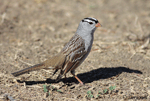 |
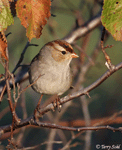 |
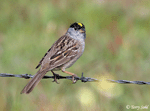 |
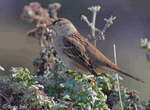 |
| White-crowned Sparrow (Adult) | White-crowned Sprrow (Immature) | Golden-crowned Sparrow (Adult) | Golden-crowned Sparrow (Immature) |
Bird Feeders:
White-throated Sparrows will attend feeders for various seeds, strongly preferring tray feeders or seed scattered on the ground rather than taking food directly from a elevated feeder with perches.
Conservation Status:
Systematic surveys in recent decades (Breeding Bird Survey and Christmas Bird Count) show relatively stable trends in most areas the last 40 years. They are found over a broad geographic area, are common in parts of their range, and have a large population overall. For these reasons, the IUCN considers the White-throated Sparrow to be a species of "Least Concern".
Further Information:
- BirdWeb - White-throated Sparrow
- WhatBird - White-throated Sparrow
- Audubon Guide - White-throated Sparrow
Photo Information:
May 5th, 2019 -- Beaver Creek Nature Area, South Dakota -- Terry Sohl
Additional Photos:
Click on the image chips or text links below for additional, higher-resolution White-throated Sparrow photos.
Audio File Credits:
- 1Martin St-Michel, XC467709. Accessible at www.xeno-canto.org/467709
- 2Ken Otter, XC340797. Accessible at www.xeno-canto.org/340797
| Click on the map below for a higher-resolution view |
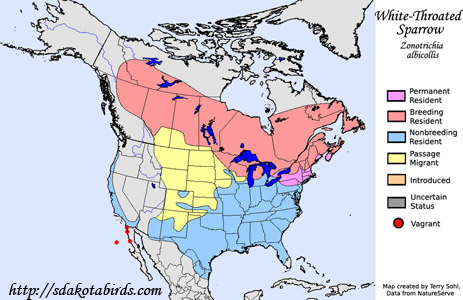 |
| South Dakota Status: Common migrant in the eastern part of the state, uncommon in the west. |
Additional White-throated Sparrow Photos
Click for a higher-resolution version of these photos

